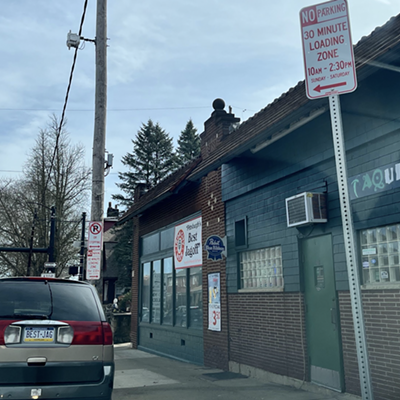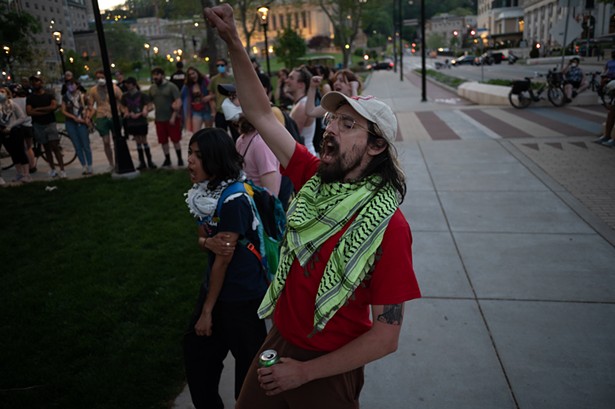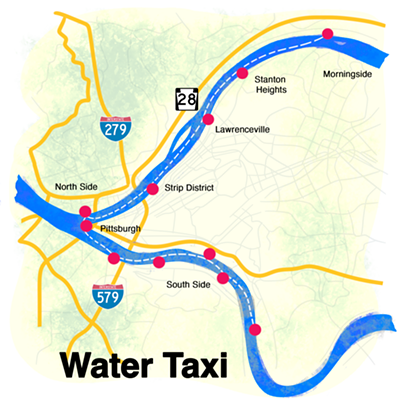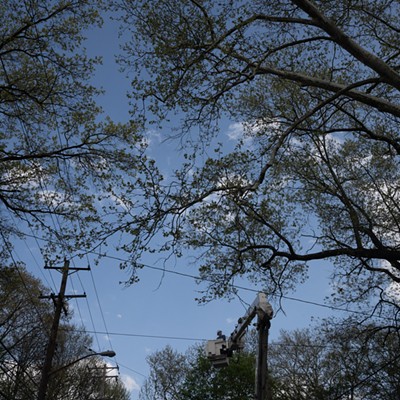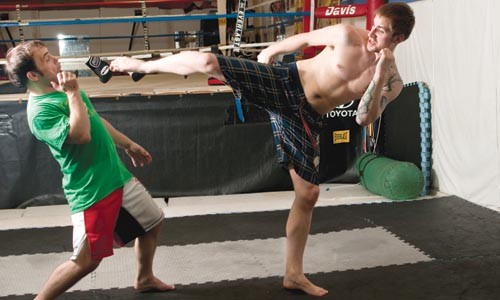
You need a license to open a barbershop in Pennsylvania. But what if you want to run a gym where you train fighters to kick, pummel and put each other in strangleholds? As far as state law is concerned, it's buyer beware.
When Pennsylvania legalized mixed martial arts in February 2009, the State Athletic Commission began regulating the fights themselves. MMA is a no-holds-barred hybrid of punching, kicking and grappling that draws fighters from various backgrounds: martial arts, wrestling and boxing. The state has license requirements for fighters, and requires medical exams at bouts. But at the amateur level, the state does nothing to certify a trainer's credentials.
"Manpower-wise, it's strictly impossible" to certify all trainers and gyms, says Greg Sirb, the commission's executive director. "Everybody's an MMA trainer now. Everybody."
Because trainers are largely unregulated, the sport is a hotbed for fraud, says local amateur fighter Jimmy Cerra, who has taught MMA locally.
"Anybody can open a gym and do what they want -- and they do," Cerra says. Some instructors exaggerate their credentials to attract more students, he adds. "It's all money."
"A lot of times, macho overrides good schooling or common sense," says Eric Hibler, owner of Pittsburgh Fight Club. "The crowd -- that's what they're interested in. They just want to see combat."
Over the past decade, MMA's popularity has ballooned, thanks in part to televised Ultimate Fighting Championship bouts and the reality fighting show Tapout. Demand for instruction has increased, Cerra says -- and so has debate about how to regulate it.
When it comes to professional, state-sanctioned fights, Sirb says, both fighters and trainers must register with the commission. The agency approves or denies the applications based on training background, fighting experience and other factors.
"When you put that all together, we try to make an educated decision," Sirb says. When background checks bring up irregularities, the SAC notifies gym owners, but "we don't have the authority" to take further action, Sirb says.
Sirb says he has encountered a few instances of fraud on applications. "I don't think it's a major problem" at the professional level, he adds.
But to be licensed at the amateur level, a fighter needs to merely list a record, the names of trainers and gyms. The state does not verify the credentials or qualifications of trainers, though it does review licenses each year and decides whether to reissue the license based on performance.
Some worry that's not enough to protect unsophisticated fighters.
"There should be some kind of safety parameters put in," says Hibler, who believes state regulation of training is necessary. "A catastrophic injury would be the first thing I would worry about."
But Hibler is in the minority. Sirb says there's been little interest in having the state regulate trainers, and Cerra, for one, doubts the state could certify instructors fairly. The sport is young and techniques evolve too rapidly for commissioners to keep up, he adds.
Still, Cerra and others agree that instructors who lie about their own training pose a danger -- both to individual fighters and to the sport as a whole.
If, for instance, instructors begin giving jiu-jitsu belt promotions without having hard-earned credentials themselves, "you don't know who's legitimate. It's lost forever in the fog," says Warren Stout, who owns the Renzo Gracie Pittsburgh Jiu-Jitsu Academy, in Lawrenceville.
In the absence of state oversight, MMA devotees are policing the sport themselves, with websites like Bullshido.net.
An online forum dedicated to uncovering fraud in martial arts, Bullshido uses a volunteer staff to investigate claims, essentially acting as fact checkers. The site began in 2002 and has staff members located throughout the United States. Bullshido spokesperson Josh Wentworth says the site has conducted roughly 50 investigations into fraudulent instructors, 10 percent of whom stopped teaching afterward. Around 150 additional forum-board claims were quickly disproved in fact checking, he adds.
"Community oversight is a more reliable yardstick than a committee that says 'Yes, you're qualified' [or] 'No, you aren't,'" Wentworth says. "I think [the Internet] has become a tool to combat fraud in many industries."
Among the gyms that have attracted scrutiny is Iron City MMA, formerly located in Brookline. When the gym closed in 2008, Bullshido forums were buzzing with criticism of its owner, Khristian Geraci. The site's investigators claimed Geraci -- an amateur fighter who previously appeared on Tapout -- had listed a false belt ranking and fight record on his gym's website.
As part of the investigation, Cerra visited Iron City MMA, sparred with students and posted a review on Bullshido saying they were not appropriately skilled for their belt rankings. "I posted those threads to warn people," Cerra tells City Paper. Crediting the investigation as a catalyst for the gym's closure, he adds: "People don't want to be confrontational a lot of times. Sometimes the truth hurts."
Multiple calls to a telephone number the State Athletic Commission has on file for Khristian Geraci were not returned. He did not respond to e-mail requests for comment sent to multiple addresses Bullshido contributors say they used previously to communicate with him.
But this past March, Geraci was quoted in the magazine Real Fighter that the Bullshido account "really ruined my gym ... The Bullshido page was, for the most part, accurate. The mistakes were mine; I let people believe things that weren't true. ... I had a good thing going at Iron City, a good group of guys, and I let that get away from me. I regret that very deeply."
Over the years, Cerra has visited local gyms to cross-train with various fighters. He recalls attending one session where an instructor invited students to hit him in the groin (he wasn't shy about returning the favor, either). While gym-hopping has led him to a few "weirdos," Cerra says, doing so offers a wider perspective of the sport. He suggests that first-time students test out multiple gyms before choosing a training spot.
"I think usually people find out pretty quickly if [instructors] are frauds," he says. Though Cerra supports Bullshido's effort to verify backgrounds, he says training with an instructor is the only fair way to judge competence.
Even Wentworth, the Bullshido spokesman, agrees that many fraud cases probably go unnoticed.
"Right now, the idea is that, 'Oh, there are so many martial-arts instructors; they'll never get to me,'" he says. "And most of the time they're right."
Sirb, of the state athletic commission, says that the sport has become increasingly popular, especially at the amateur level. As of July 1, the SAC licensed 382 amateur and 104 professional MMA fighters in 2010 -- that's compared to 333 amateur and 209 professional fighters in all of 2009. Sirb estimates the commission turns down fewer than 5 percent of its applicants -- usually because a fighter is too young or too old. (Fighters must be 18 to compete, and Sirb recommends they stop competing around age 36.) Less frequently, Sirb says, poor fight records dissuade the SAC from licensing a fighter.
Hibler thinks the sport's television and Internet presence are producing more discerning students: "I had kids coming into my place who were 14 years old and just laying out how they wanted to be trained," he says.
In fact, the best approach for students is to be well armed -- with information. Chuck Hardin, head investigator at Bullshido, says that "as far as I know, the Internet is the only place [for the MMA community] to do that kind of quality control." But even Hardin warns that skepticism of online posts is necessary.
"Go to the Internet," he says, "but don't believe everything you run across."



